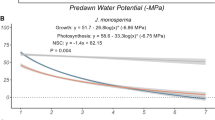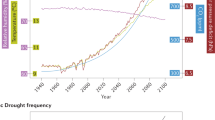Abstract
Climate projections predict higher precipitation variability with more frequent dry extremes1. CO2 assimilation of forests decreases during drought, either by stomatal closure2 or by direct environmental control of sink tissue activities3. Ultimately, drought effects on forests depend on the ability of forests to recover, but the mechanisms controlling ecosystem resilience are uncertain4. Here, we have investigated the effects of drought and drought release on the carbon balances in beech trees by combining CO2 flux measurements, metabolomics and 13CO2 pulse labelling. During drought, net photosynthesis (AN), soil respiration (RS) and the allocation of recent assimilates below ground were reduced. Carbohydrates accumulated in metabolically resting roots but not in leaves, indicating sink control of the tree carbon balance. After drought release, RS recovered faster than AN and CO2 fluxes exceeded those in continuously watered trees for months. This stimulation was related to greater assimilate allocation to and metabolization in the rhizosphere. These findings show that trees prioritize the investment of assimilates below ground, probably to regain root functions after drought. We propose that root restoration plays a key role in ecosystem resilience to drought, in that the increased sink activity controls the recovery of carbon balances.
This is a preview of subscription content, access via your institution
Access options
Subscribe to this journal
Receive 12 digital issues and online access to articles
$119.00 per year
only $9.92 per issue
Buy this article
- Purchase on Springer Link
- Instant access to full article PDF
Prices may be subject to local taxes which are calculated during checkout




Similar content being viewed by others
References
IPCC Managing the Risks of Extreme Events and Disasters to Advance Climate Change Adaptation Vol. 582 (Cambridge Univ. Press, 2012).
McDowell, N. et al. Mechanisms of plant survival and mortality during drought: why do some plants survive while others succumb to drought? New Phytol. 178, 719–739 (2008).
Körner, C. Carbon limitation in trees. J. Ecol. 91, 4–17 (2003).
Reichstein, M. et al. Climate extremes and the carbon cycle. Nature 500, 287–295 (2013).
Pan, Y. et al. A large and persistent carbon sink in the world's forests. Science 333, 988–993 (2011).
Ciais, P. et al. Europe-wide reduction in primary productivity caused by the heat and drought in 2003. Nature 437, 529–533 (2005).
Zha, T. S. et al. Gross and aboveground net primary production at Canadian forest carbon flux sites. Agr. Forest Meteorol. 174–175, 54–64 (2013).
Guillemot, J. et al. The dynamic of the annual carbon allocation to wood in European tree species is consistent with a combined source–sink limitation of growth: implications for modelling. Biogeosciences 12, 2773–2790 (2015).
Fatichi, S., Leuzinger, S. & Körner, C. Moving beyond photosynthesis: from carbon source to sink-driven vegetation modeling. New Phytol. 201, 1086–1095 (2014).
Klein, T. & Hoch, G. Tree carbon allocation dynamics determined using a carbon mass balance approach. New Phytol. 205, 147–159 (2015).
Ruehr, N. et al. Effects of drought on allocation of recent carbon: from beech leaves to soil respiration. New Phytol. 184, 950–961 (2009).
Arndt, S. K., Clifford, S. C., Wanek, W., Jones, H. G. & Popp, M. Physiological and morphological adaptations of the fruit tree Ziziphus rotundifolia in response to progressive drought stress. Tree Physiol. 21, 705–715 (2001).
Galvez, D. A., Landhausser, S. M. & Tyree, M. T. Root carbon reserve dynamics in aspen seedlings: does simulated drought induce reserve limitation? Tree Physiol. 31, 250–257 (2011).
Sala, A., Woodruff, D. R. & Meinzer, F. C. Carbon dynamics in trees: feast or famine? Tree Physiol. 32, 764–775 (2012).
Hasibeder, R., Fuchslueger, L., Richter, A. & Bahn, M. Summer drought alters carbon allocation to roots and root respiration in mountain grassland. New Phytol. 205, 1117–1127 (2015).
Ashraf, M. & Foolad, M. R. Roles of glycine betaine and proline in improving plant abiotic stress resistance. Environ. Exp. Bot. 59, 206–216 (2007).
Wiley, E. & Helliker, B. A re-evaluation of carbon storage in trees lends greater support for carbon limitation to growth. New Phytol. 195, 285–289 (2012).
Unger, S., Máguas, C., Pereira, J. S., David, T. S. & Werner, C. The influence of precipitation pulses on soil respiration – assessing the “Birch effect” by stable carbon isotopes. Soil Biol. Biochem. 42, 1800–1810 (2010).
Birch, H. F. Mineralisation of plant nitrogen following alternate wet and dry conditions. Plant Soil 20, 43–49 (1964).
Ogle, K. et al. Quantifying ecological memory in plant and ecosystem processes. Ecol. Lett. 18, 221–235 (2015).
Kuzyakov, Y. & Gavrichkova, O. Review: Time lag between photosynthesis and carbon dioxide efflux from soil: a review of mechanisms and controls. Glob. Change Biol. 16, 3386–3406 (2010).
Volkmann, T., Haberer, K., Gessler, A. & Weiler, M. High-resolution isotope measurements resolve rapid ecohydrological dynamics at the soil-plant interface. New Phytol. 210, 839–849 (2016).
Lehto, T. & Zwiazek, J. J. Ectomycorrhizas and water relations of trees: a review. Mycorrhiza 21, 71–90 (2011).
Anderegg, W. R. L. et al. Pervasive drought legacies in forest ecosystems and their implications for carbon models. Science 349, 528–532 (2015).
Hill, P. W. et al. Living roots magnify the response of soil organic carbon decomposition to temperature in temperate grassland. Glob. Change Biol. 21, 1368–1375 (2015).
Tognetti, R., Michelozzi, M. & Borghetti, M. The response of European beech seedlings from two Italian populations to drought and recovery. Trees Struct. Funct. 9, 348–354 (1995).
Gallé, A. & Feller, U. Changes of photosynthetic traits in beech under severe drought stress and during recovery. Physiol. Plant. 131, 412–421 (2007).
Albert, K. R., Mikkelsen, T. N., Michelsen, A., Ro-Poulsen, H. & van der Linden, L. Interactive effects of drought, elevated CO2 and warming on photosynthetic capacity and photosystem performance in temperate heath plants. J. Plant Physiol. 168, 1550–1561 (2011).
Bader, M. K. F. & Körner, C. No overall stimulation of soil respiration under mature deciduous forest trees after 7 years of CO2 enrichment. Glob. Change Biol. 16, 2830–2843 (2010).
Lang, S. Q., Bernasconi, S. M. & Früh-Green, G. L. Stable isotope analysis of organic carbon in small (µg C) samples and dissolved organic matter using a GasBench preparation device. Rapid. Comm. Mass Spectrom. 26, 9–16 (2012).
Högberg, P. et al. High temporal resolution tracing of photosynthate carbon from the tree canopy to forest soil microorganisms. New Phytol. 177, 220–228 (2008).
Ohlsson, K. E. A. et al. Uncertainties in static closed chamber measurements of the carbon isotopic ratio of soil-respired CO2 . Soil Biol. Biochem. 37, 2273–2276 (2005).
Subke, J. A. et al. Feedback interactions between needle litter decomposition and rhizosphere activity. Oecologia 139, 551–559 (2004).
Erxleben, A., Gessler, A., Vervliet-Scheebaum, M. & Reski, R. Metabolite profiling of the moss Physcomitrella patens reveals evolutionary conservation of osmoprotective substances. Plant Cell Rep. 31, 427–436 (2012).
Gessler, A. et al. On the metabolic origin of the carbon isotope composition of CO2 evolved from darkened light-acclimated leaves in Ricinus communis. New Phytol. 181, 374–386 (2009).
Schneider, S. et al. Soluble N compounds in trees exposed to high loads of N: a comparison of spruce (Picea abies) and beech (Fagus sylvatica) grown under field conditions. New Phytol. 134, 103–114 (1996).
Pinheiro, J., Bates, D., Debroy, S. & Sarkar, D., the R Core Team Nlme: Linear and Nonlinear Mixed Effects Models R package version 3.1–118 (CRAN, 2014); http://CRAN.Rproject.org/package=nlme
van Bel, A. The phloem, a miracle of ingenuity. Plant Cell Environ. 26, 125–149 (2003).
Acknowledgements
We thank P. Bleuler for technical assistance and for maintaining the model ecosystem facility. We also thank B. Meier, R. Appenzeller, Y. Bicker, D. Brödlin, D. Christen, N. Hajjar, R. Köchli, F. Schreyer and A. Zürcher for their help with sampling and measurements, and F. Buegger, L. Schmidt and A. Schlumpf for completing the isotope analysis. We are grateful to M. Dawes for critically reading and providing helpful comments on the manuscript. This work was supported by funding from the Swiss Federal Institute for Forest, Snow and Landscape Research WSL and the Swiss Federal Office for the Environment FOEN.
Author information
Authors and Affiliations
Contributions
M.A., R.S., F.H., M.S. and A.G. designed the experiments; R.S., F.H., J.J. and M.A. performed the 13C pulse labelling; F.H., K.S. and M.A. measured seasonal CO2 fluxes and chlorophyll fluorescence; M.A., M.P., K.P., U.G., R.K., V.M., S.E. J.L., J.J., M.W., R.S. and F.H. analysed 13C allocation patterns; A.G., J-F.L. and M.L. analysed metabolites; J.J. and F.H. performed statistical analysis; A.G., J.J., F.H. and M.A. wrote the manuscript.
Corresponding author
Ethics declarations
Competing interests
The authors declare no competing financial interests.
Supplementary information
Supplementary Information
Supplementary Figs 1-4, Supplementary Tables 1-4 and Supplementary Methods. (PDF 510 kb)
Rights and permissions
About this article
Cite this article
Hagedorn, F., Joseph, J., Peter, M. et al. Recovery of trees from drought depends on belowground sink control. Nature Plants 2, 16111 (2016). https://doi.org/10.1038/nplants.2016.111
Received:
Accepted:
Published:
DOI: https://doi.org/10.1038/nplants.2016.111
This article is cited by
-
Symbiotic mycorrhizal types affect patterns of tree aboveground and belowground C allocation in Northeast China
Ecological Processes (2023)
-
Divergent responses of belowground carbon investment in Quercus spp. and Acer saccharum to reduced precipitation
Biogeochemistry (2023)
-
Water limitation intensity shifts carbon allocation dynamics in Scots pine mesocosms
Plant and Soil (2023)
-
Ectomycorrhizal fungi mediate belowground carbon transfer between pines and oaks
The ISME Journal (2022)
-
Effects of long-term nitrogen addition and precipitation reduction on the fine root dynamics and morphology in a temperate forest
European Journal of Forest Research (2022)



